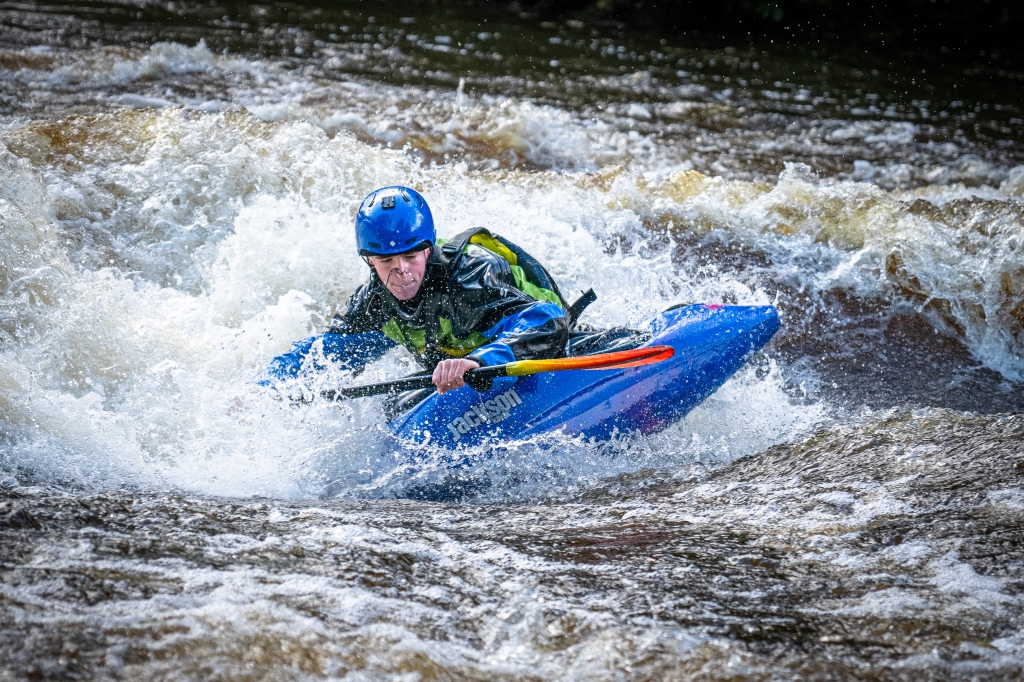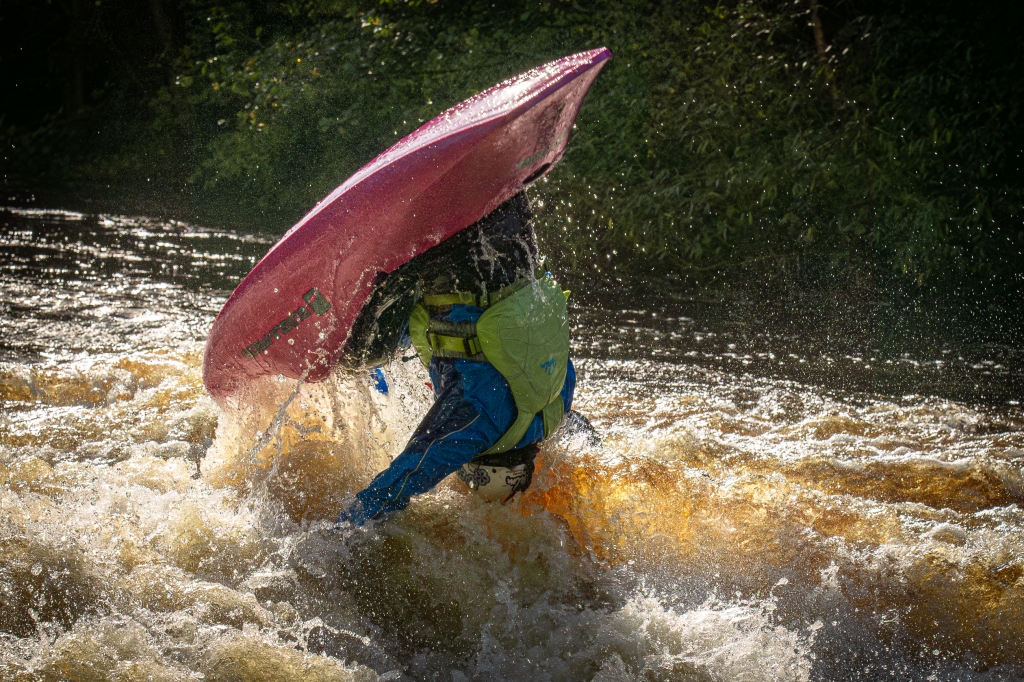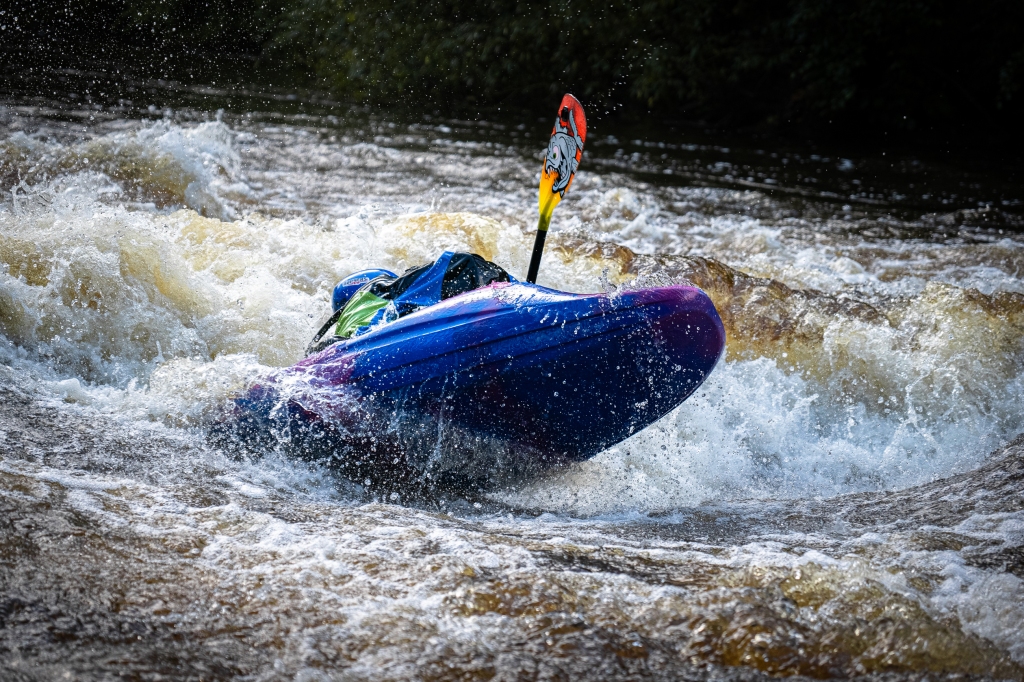The freestyle kayaking scene in the UK is doing pretty well, all things considered, but worldwide is a different proposition.
In the UK, freestyle kayaking and canoeing is doing pretty well. The fact that UK rivers are entirely rain dependent means that in the drier weeks and months one of the only ways to get a boating fix is to go to either a man-made whitewater course or a feature that generally runs all the time, even if small. This often means using a freestyle boat for park & play.
The take-up of freestyle amongst younger people also seems pretty good right now. However, I recently ran a survey for those who don’t do freestyle, or who dislike it, to find out why they don’t want to do it or what might be holding them back. It seems that while freestyle in the UK is fairly popular in comparison to some places, in the rest of the world it isn’t so much.
In the US, it seems that the idea of freestyle really splits people’s opinions. Despite guys like Dane Jackson, Nick Troutman, Tom Dolle, Landon Miller and many more pushing the sport and its benefits to general boating skills across social media, some still remain dead set against it.
Surveying people’s attitudes to freestyle kayaking
Some of the responses that the survey received were surprising. From some respondents unable or unwilling to see the benefits, with one in particular saying it had no practical use, to those who just didn’t like going upside down, to some who thought it was the dumbest thing on the planet. It took me aback at how vehement and strong some of the feelings towards it were.
Now, with regard to practical use, I don’t really think it takes much to realise that freestyle gives paddlers skills to get out of sticky situations, increases boat control and awareness, and also improves the ability to stay calm under pressure. It also hugely improves a participant’s combat roll. Finally, freestyle gives you the ability to go boating when there’s not much water about.
Another criticism I saw was that some respondents thought that doing aerial loops and moves looked silly and dorky. Say wha?! I’m not going to dignify that with a response, but some others did comment that all the moves looked the same and that it was a poor spectator sport.
Okay, for one thing, I don’t think most people who do freestyle do it for the spectator value. That said, if you don’t believe that it’s spectator friendly I would suggest going to inlet gate at HPP in Nottingham on a sunny weekend and look at all the members of the public gathering around the bridge to watch, fascinated by the big loops and moves. Further, go to a World Championship Final and try to tell me that the spectators aren’t engaging with it!
The fact is, just as with many sports, it’s sometimes hard to follow the moves until you are familiar with them. I haven’t got a clue what’s going on in American Football, and I don’t have much of an idea about Rugby. Although regarding the latter, once I watched a big match on TV with someone who could explain to me what was going on, I actually started to enjoy it.
Here’s a fun fact. When I first started whitewater kayaking, I too thought that freestyle looked silly. But, as with the Rugby, I eventually took the time to understand it, and now I can see what all the moves are, as well as directly appreciating the skill that goes into it through participation. But even still, some people are seeing freestyle as simply tumbling around in a small hole somewhere. The reality is, unsurprisingly, very different.
From World Championships that have taken place on Garb wave and Good Wave, to the Stakeout competitions, they are often held on anything but a tiny pokey hole somewhere. Sure, some World Champs do take place in small holes, but that’s just a venue choice limitation. Otherwise they’d be stuck in Canada or the US constantly.
Further, while I love river running, I could easily point out to the person who said that all freestyle looks the same, that once you’ve seen one kayaker go off a waterfall, you’ve seen them all. I wouldn’t really mean it because I respect the skill of big waterfall running, but I could easily fire that argument back at them, because there is some truth to it from a spectator point of view.
I think what struck me most was that there’s a lot of attitude out there that stems from the standpoint of not understanding it, instead of taking the time to understand the skill in it and simply admitting honestly that it isn’t for them.
Anything more positive to take?
Okay, so those were some of the negative points, what about the positives, or rather less negative points?
Well, it was clear that there were two main reasons why those who actually did want to try freestyle out but hadn’t done so yet hadn’t been able to. The first reason was a lack of suitable venue. In the UK we’re lucky in that we have a lot of artificial white water centres across the country. In a place like the US, although such places exist, it might involve a lot of travelling if there’s no suitable river feature available locally.
The next reason was that a lot of respondents simply didn’t know how to start in freestyle and had no access to suitable people or coaches to help them. Again, in the UK this is less of an issue since intro courses run by people like Lowri Davies, Paddle365, and Rock The Boat Activities among others are a regular occurrence.
Roll confidence
Yet another reason was a lack of confidence in the roll. I’m a bit of a hypocrite on this front given my current head games issues, but I’m still going to lay things down. Freestyle will improve your roll. Massively. I keep repeating this story, but when I got Emily into a freestyle boat and messing around in waves and holes, her roll went from extremely hit and miss to a 80-90% hit rate within a matter of 2-3 weeks. Eventually she rarely ever swam, and it was 100% because she was doing freestyle.
If you’re waiting until your river roll improves before trying freestyle, you’re expecting the seeds to grow before giving them any water. Yes, if your roll is hit and miss, or you’ve not long started, you will swim a lot. But if you’re in a friendly venue like the bottom wave at CIWW or at Mile End Mill in Wales on a summer’s day, it’s fine.
You’ll fast develop edge balance and control and quickly improve your roll hit rate. Because I don’t get to run rivers a lot, freestyle is the only way that I’ve kept some semblance of ability in my boating, even if I go a bit rusty when it comes to some other areas.
Some responses to the survey made me laugh, such as one that said that there are downriver boaters who can loop their kayaks, but who don’t do freestyle. Well, I doubt they got good looping technique without knowing something about freestyle, since bringing a long river boat around in the air requires super solid technique. And, you know what else? If they are doing that, even if it’s on a river run, they are still engaging in freestyle!
There’s this very limited attitude by some that freestyle consists only of short boats on a set feature. It isn’t. If you surf your boat on a green wave, if you do kick flips down river, if you do basic spins in a hole on a trip, if you tailie your half slice, or do rock splats or rock spins, you are doing freestyle. The clue is in the name! There’s no exclusive use of the term ‘freestyle’ by the ICF. It encompasses doing tricks of all types, whether it’s in a short boat at a park & play venue or styling it down river.
What can be done about it?
I think first and foremost, there needs to be more out there about the benefits of doing freestyle, with more active promotion. GB Freestyle is doing a lot of work with clubs around the UK to try and change perceptions, as well as to assist with coaching opportunities. There are no such initiatives in countries like the US, which is important if freestyle is to flourish in the future.
I don’t believe that freestyle will ever go the same way as squirt boating, but it will struggle to move forward if there’s no positive drive or promotion of it. It is puzzling to me, given how much freestyle content people like Dane Jackson put out there, that it hasn’t got a larger take up in the US. After all, Dane is known as the GOAT of white water kayaking. He’s the closest we’ve got to Kelly Slater in surfing. He excels at whichever kayaking discipline he does, and freestyle plays a huge part in his image and that cuts a lot of sway in terms of influencing people. Or at least, you’d have thought so.
However, as I saw from my survey, many of the obstacles to people outside of the UK come down to the accessibility of a suitable feature and coaching. The ACA (American Canoe Association) is one of the main bodies in the US, and I don’t know what it does to foster freestyle promotion and development. Although it does seem clear that there’s a very different attitude towards it in the US vs Europe.
Conclusions
I’m going to re-iterate another point that I’ve made many times over. If you name me any of the most well known top white water kayakers right now, I will guarantee you that they either got their start in freestyle, compete or take part regularly in freestyle, or at the very least are very capable at it because they recognise the skills it gives them. Don’t believe me? Here’s a short list in no particular order…
Bren Orton, Adrian Mattern, Dane Jackson, Eric Jackson, Emily Jackson, Nick Troutman, Kalob Grady, Tom Dolle, Quim Fontané, Heidi Walsh, Landon Miller, Aniol Serrasolses, Gerd Serrasolses, Nouria Newman, Benny Marr, Rush Sturges, Evan Garcia, Sage Donnelly to name a few.
There are many, many lesser known, but still very high level paddlers for who freestyle played a big part in their skills development. The main thing to understand here as ‘weekend warriors’, is that even if some of those top guys no longer compete or do much now, freestyle played an important role initially.
An even more important takeaway is that many of them became good at multiple disciplines. It’s known in sports science now that variety of practice is more important than focussing on one thing. Variety can and does also mean engaging in different activities, too.
For example, you’ll find that many of the top kayakers I mentioned are often pretty handy at other sports like mountain biking, climbing, snowboarding and skiing etc. I meet a fair few boaters who don’t want to try other sports because they are afraid of missing out on river days and becoming good at that, when the reality is that doing other sports and activities actually helps your boating with transferable skills.




Recent comments